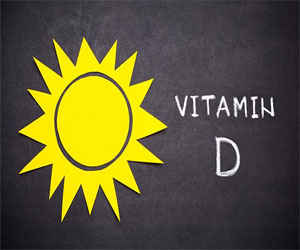- Home
- Editorial
- News
- Practice Guidelines
- Anesthesiology Guidelines
- Cancer Guidelines
- Cardiac Sciences Guidelines
- Critical Care Guidelines
- Dentistry Guidelines
- Dermatology Guidelines
- Diabetes and Endo Guidelines
- Diagnostics Guidelines
- ENT Guidelines
- Featured Practice Guidelines
- Gastroenterology Guidelines
- Geriatrics Guidelines
- Medicine Guidelines
- Nephrology Guidelines
- Neurosciences Guidelines
- Obs and Gynae Guidelines
- Ophthalmology Guidelines
- Orthopaedics Guidelines
- Paediatrics Guidelines
- Psychiatry Guidelines
- Pulmonology Guidelines
- Radiology Guidelines
- Surgery Guidelines
- Urology Guidelines
Oral vitamin D supplements raise blood levels better than enhanced sun exposure

Oral vitamin D supplementation raises its blood levels better than enhanced sun exposure.
Vitamin D and sunlight both are essential for life. Its deficiency can lead to back and bone problems and also increases susceptibility to infections. Despite this fact, Vitamin D deficiency prevails in about 80% of the Indian population. Now a new study has found that ≥ 20–30 minutes daily sun exposure with vitamin D supplementation significantly increases serum viatmin D concentration in the body.
The study, published in the journal Clinical Nutrition has found that enhanced sun exposure (daily ≥ 20–30 min around noon) and 500 IU/d of oral vitamin D3 supplementation significantly increased serum 25OHD concentrations. Further, the enhanced sun exposure was not as effective as 500 IU/d of oral vitamin D3supplementation.
The major circulating form of vitamin D is 25-hydroxyvitamin D (25(OH)D); thus, the total serum 25(OH)D level is currently considered the best indicator of vitamin D supply to the body from cutaneous synthesis and nutritional intake.
The reference range of the total 25(OH)D level is 20-100 ng/mL.
There are two principal forms of vitamin D: D2 and D3. Many of the currently available assays measure and report on both vitamin D2 and D3 metabolites. This can be useful in studies evaluating the contribution of vitamin D2 and D3 to overall vitamin D status. 25-hydroxyvitamin D (25(OH)D) is the major circulating form of vitamin D; thus, the total serum 25(OH)D level is currently considered the best indicator of vitamin D supply to the body from cutaneous synthesis and nutritional intake.
Vitamin D inadequacy is associated with a wide range of diseases. However, optimal strategies to improve vitamin D status, especially in Asian populations, remain unclear. Hee-Kyung Joh, Department of Medicine, Seoul National University College of Medicine, Seoul, Korea, and colleagues tested the hypotheses:
- relevant sun exposure or oral vitamin D supplementation would significantly increase serum 25-hydroxyvitamin D (25OHD) concentrations compared with placebo
- sun exposure and supplementary vitamin D would be similar in serum 25OHD increases, and
- the two interventions may have different effects on cardio-metabolic markers.
The researchers investigated the impact of sun exposure vs oral vitamin D supplementation on serum 25-hydroxyvitamin D levels in young adults in this 8-week randomized, placebo-controlled clinical trial. Specifically, they compared vitamin D-deficient adults in Seoul, Korea, with respect to changes in serum 25OHD concentrations. Participants were assigned to sun exposure (daily ≥ 20–30 minutes around noon; n=50), oral vitamin D3 (500 IU/d; n=50), and control (placebo; n=50) groups.
Key findings of the study include:
- Both sun exposure and oral vitamin D3 effectively increased serum 25OHD concentrations.
- Compared with placebo, the between-group least-squares mean (LSM) differences in changes were 2.2 ng/mLin the sun exposure group and 8.5 ng/mL in the oral vitamin D3 group.
- Increases in serum 25OHD were greater with oral vitamin D3 than with sun exposure.
- More participants in the oral vitamin D3 group (54.2%) achieved serum 25OHD concentrations ≥20 ng/mL at week 8 than those in the sun exposure (12.2%) or control (4.3%) groups.
- Compliance with sun exposure advice was relatively low, and only those with adequate compliance had a significant increase in serum 25OHD.
- Changes in the cardio-metabolic markers were mostly insignificant in all groups.
"Enhanced sun exposure and 500 IU/d of oral vitamin D3 supplementation significantly increased serum 25OHD concentrations. However, our protocol for sun exposure was not as effective as 500 IU/d of oral vitamin D3supplementation," concluded the authors.
For detailed study log on to https://doi.org/10.1016/j.clnu.2019.03.021

Disclaimer: This site is primarily intended for healthcare professionals. Any content/information on this website does not replace the advice of medical and/or health professionals and should not be construed as medical/diagnostic advice/endorsement or prescription. Use of this site is subject to our terms of use, privacy policy, advertisement policy. © 2020 Minerva Medical Treatment Pvt Ltd